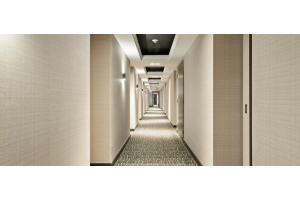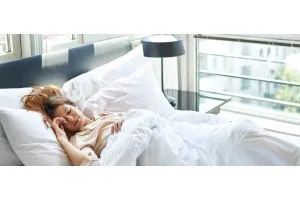We use cookies to give you the best possible experience. To accept cookies continue browsing, or view our Cookies Policy to find out more.
How to Choose Hotel Bedding: A Hotel Owners Guide
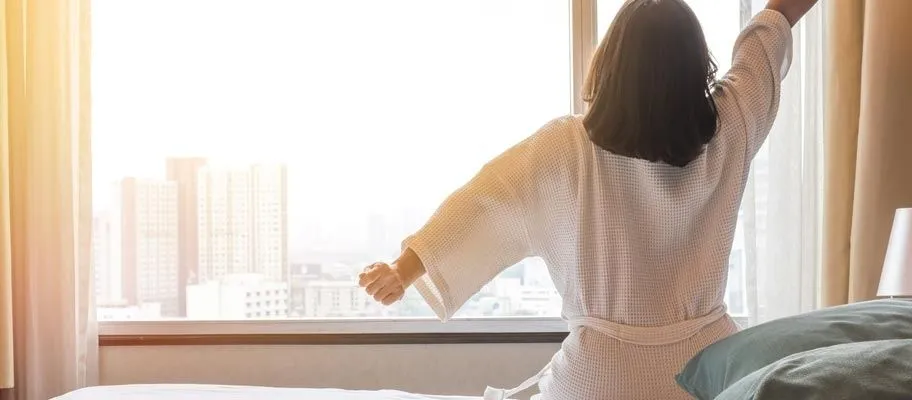
With more and more hoteliers investing time and effort into ensuring their guests have a great night's sleep, it's time to wake up and smell the proverbial coffee because sleep is big business. Aside from environmental factors which can all influence the way we sleep, there's one thing that hoteliers can do to ensure their guests drift off like a dream as soon as their head hits that pillow. And that's ensuring they choose the best possible hotel bedding to guarantee the visitors that come through the door will return, time and time again. We previously looked into the science of sleep; why it's important, the effects of sleep debt and how hoteliers can ensure a soft and seamless slumber each and every time. But it's also important to consider how hotel owners' hotel bedding choices can also influence the way a room feels and, therefore, how the room can provide an optimal sleeping environment.
To find out more about specific areas, such as the best pillows and bathrobes to buy, check out our buyers guides page.
What Fabric Should I Choose?
Cotton
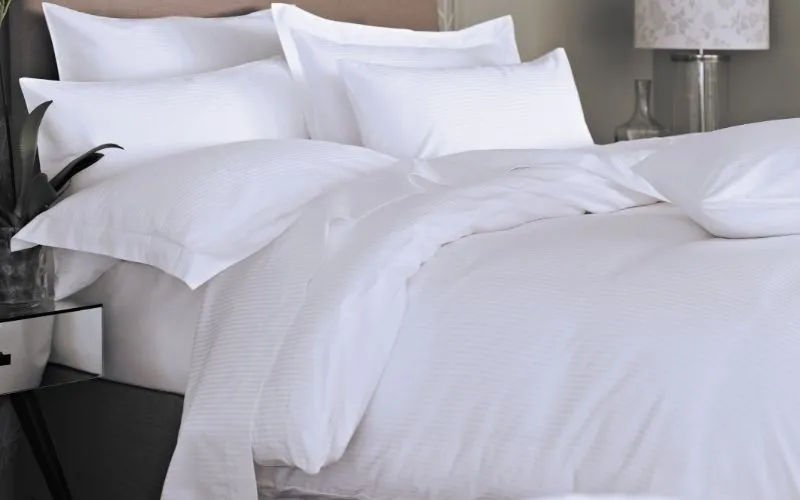
Undoubtedly the most common type of bed linen material, cotton is a popular choice for B&Bs and five-star hotels alike. Cotton is durable, breathable, easy to care for, easy to launder and offers great value for money as well as being incredibly long-lasting
Mercerised cotton is an increasingly popular choice for hoteliers as it gives the fabric a lustrous and illuminating appearance proving it to be a fantastic luxury bed linen option. Mercerising the cotton involves a process in which sodium hydroxide is applied to the cotton fibres. This treatment makes the fabric stronger, increases its resistance to mildew and makes it easier to dye meaning sheets are noticeably brighter for longer.
This 100% cotton satin stripe duvet cover, from the Vision V range of luxury linen, offers a smooth and silky feel and is one of Vision's bestsellers. This mercerised cotton duvet cover has an impeccable lustre, increased strength and a smoothness which is favoured by a range of boutique and high-end hotels.
Mercerised cotton does not shrink as much as un-mercerised cotton and so the treatment is perfect for accommodation providers who need to undergo a more rigorous washing process than those at home. For example, the 300 thread count 100% cotton sateen duvet cover, from the Vision V range, has an incredibly durable feel that has been designed to last and provide comfort for a longer period and the sateen construction gives a sheen reminiscent of satin, resulting in a softer sleeping experience.
What About Egyptian Cotton?
Egyptian cotton is typically regarded as the crème-de-la-creme of cotton and is generally thought of as the most superior type; associated with hotel quality and high-end products but the country itself is not one of the world's top producers of cotton. In fact, many products labelled Egyptian cotton are not actually from Egypt at all – only named so because they include the longer staple, high-quality cotton that we have come to associate with Egypt.
The quality of the cotton is vital when crafting hotel linen. The quality of cotton can be determined by the growing conditions in the country of origin such as the weather, the soil and the climate or temperature as well as the type of plant.
For more on Egyptian cotton, take a look at our Egyptian cotton explained article.
Polycotton Blends
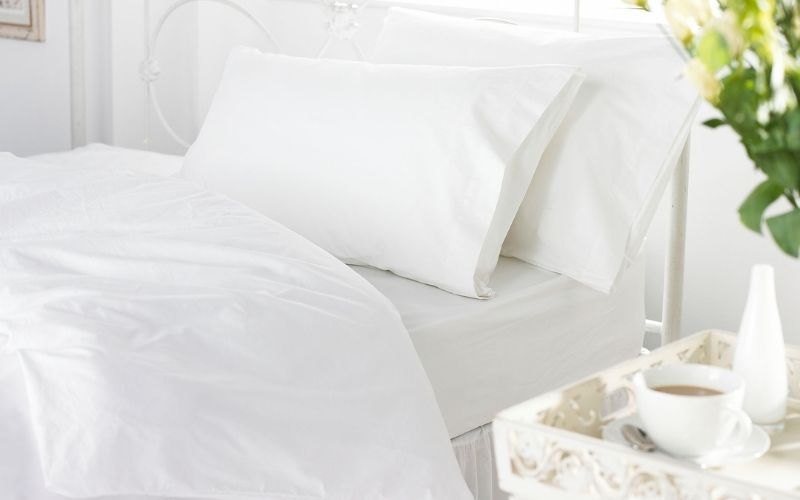
Polycotton blends are also growing in popularity as the go-to-bed linen for hotels. Considerably cheaper than 100% cotton, these blends are durable and incredibly versatile. Whilst cotton needs to be ironed and has a tendency to wrinkle, polycotton blends are less susceptible to wrinkles, static and shrinkage from washing.
With a soft feel and quick drying properties, it's a budget solution for busy housekeepers who need to ensure a smooth rotation of linen at all times and so these blends make a great alternative to cotton bed linen in a busy, commercial environment where regular washing occurs.
The 144 thread count polycotton duvet cover, is one such product that offers a wide range of benefits. One of our bestsellers, it's highly sought after thanks to its easy to care for properties and economical drying times.
Other blends include a 70/30 cotton rich blend of bed linen which offers more of the qualities that people know and love in 100% cotton combined with the cost-effective and commercially viable performance qualities of polyester. For example, our cotton rich flat bed sheet, provides a durability that can withstand repeated wash cycles as well as an easy-to-clean and easy-iron fabric that is less prone to creasing.
Linen
Linen is a natural material made from the fibres of the flax plant. Linen is renowned because it creases easily, which in terms of bedding may not be what you are looking for, however, if you want that natural, boho chic look Linen bedding is a great choice as you will never need to iron! Linen is a more expensive natural choice of material, however, it is naturally durable and will last longer than other fabrics. We currently stock some linen bedding from Lazy Linen over on our sister site, Vision Linens Home.
Is Thread Count Important When Choosing Bedding?
How important is thread count when choosing your hotel bedding? Does it even matter at all? Put simply, it's one of a few things that should be looked at when choosing your bed linen but it's not the be-all-and-end-all and it's important to look at the finish, fabric and quality that matters as well as the thread count.
So, what is thread count? In its simplest form, thread count is the number of both vertical and horizontal threads per square inch of fabric. Generally speaking, yes, the higher the thread count, the softer your fabric will be and so look out for thread counts above 200 for a truly opulent feel.
That being said, occasionally you may come across thread counts of over 1,000. In order to encourage people into thinking they're buying into true lavishness, some retailers actually twist multiple yarns of thread together which culminates in a 1,000 thread count and above but these inflated thread counts don't actually improve the quality in any way and can sometimes even hinder it. In fact, some studies suggest that the maximum of threads that can be woven into a square inch of fabric is only 500-600.
The optimum thread count for luxurious bedding is generally regarded as between 300-400 range however even 200-thread count linen can also be incredibly comfortable due to its finish and fabric quality. Our 200 thread count 100% cotton duvet cover, for example, guarantees style as well as comfort with a dazzling white appearance.
Colour
Typically, hotels favour white bed linen above all. Why? An international symbol of luxury, visually dazzling white linen creates the illusion of peace, luxury and above all, a restful place to sleep. It's simple, clean and inviting which is exactly what guests need when looking to evaluate a guest bedroom and some studies have shown it also enhances the sense that a room has just been redecorated – even if only the bedding or bed has been changed. Find out more about why hotels use white bedding.
Satin stripe options are a go-to bed linen look that is sure to make bedrooms look elegant, luxurious and ensures the bed is the focal point whilst the plain options are really great for creating a simple and neat finish. Why not try the V200 200 thread count 100% cotton duvet cover for a truly lavish and high-end look?
Different Types Of Bedding Fabric Weaves
Percale
A type of weave used when manufacturing bedding, the percale weave is a one-under-one-over weave which ultimately produces a stronger fabric. The result is that a percale weave is sufficiently durable, even after multiple washes and it's generally found on the higher thread count bedding. The threads in a percale weave are tightly woven to ensure a fine texture and finish.
Sateen
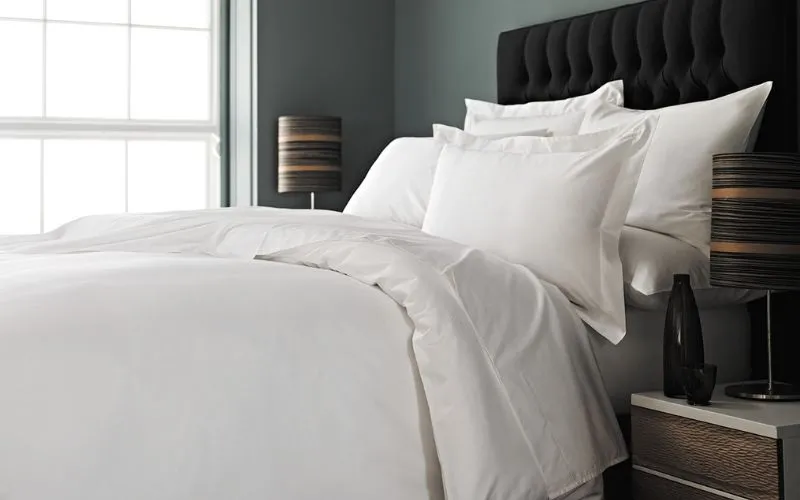
A sateen weave is used using a four-over-one-under process. The result is a lustrous and shiny, almost satin-like feel to the fabric. Typically associated with high-end bed sheets and accessories, sateen sheets are incredibly soft and are great for sleeping during the winter months whilst percale bed sheets offer a cooler feeling when under them.
Jacquard
Jacquard weaving is an intricate and delicate type of weave where a pattern is woven into a fabric and jacquard designs have been commonly seen in linen damask tablecloths and napkins, handkerchiefs and damask bed linen, such as those associated with our prestigious luxury brand, Vision V. Jacquard designs can be created through the raising of the original fabric or from fabrics woven into the fabric from coloured yarns. Jacquard weaving is one of the oldest forms of weaving being used to this day and is woven directly into the cloth as opposed to being printed on separately meaning it's more likely to retain the detailing wash after wash.
Damask
A term used to describe fabric with a patterned weave; damask weaves are commonly found in the higher end linens but have also been noticed in tablecloths, napkins and bedding. The name comes from Damascus; once the centre of cloth trade between the East and West. As it's a lustrous cloth with an unmistakeable sheen, it later became integrated into everyday fashions of the time and is identified by the damask being visible on both sides of the fabric. Irish damask is perhaps the most famous due to its shamrock and Celtic patterns.
Do I Choose Natural Filled Bedding or Synthetic Filled?
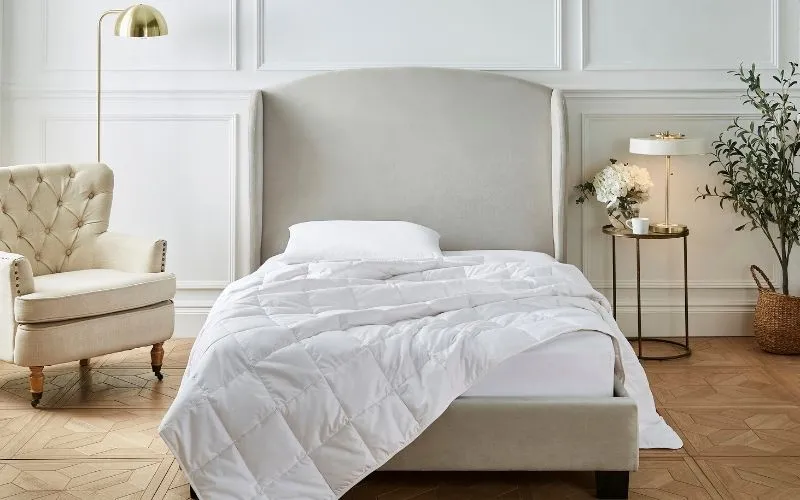
Vision has a wide range of duvet fillings designed for every eventuality and every purpose. Our polyester duvets can provide warmth during winter whilst we also offer cosy duck or goose feather and down options, as well as cashmere duvets, which are sumptuous and lavish.
For a long-lasting duvet designed to suit any season, consider a polycotton. Or, to emulate the opulent feel of down without the worries of amplifying allergies, just like down duvets are an ideal alternative.
We also stock flame retardant duvets which are designed specifically with demanding environments in mind. Tested to British and European safety standards, the flame retardant line of products from our specialist collection have been stringently checked and approved by various fire and rescue services across the UK.
We've also put together a detailed article on the types and benefits of natural and synthetic bedding.
How Does an All-Seasons Duvet Work?
The all-seasons duvets from the Vision range consist of two individual duvets which are held together at various points to provide a superior level of insulation.
One duvet is a lighter tog rating, which can be used as a stand-alone duvet during summer whilst one, featuring a heavier tog rating, is perfect for colder weather. When required, simply put them together to provide a snug, cosy duvet perfect for winter weather.
Which Tog Rating is Best For a Duvet?
The lower the tog rating, the lower level of insulation it offers. Therefore, tog ratings of around 4.5 are lighter and perfect during summer months when a low level of insulation is needed due to the surrounding temperature.
A 10.5 tog rating is generally better during the spring or autumn seasons or with a blanket during winter whilst a 15 tog offers one of the highest levels of insulations for when the temperature is at its lowest and will therefore keep the body comfortable, snug and ultimately, warm.
What Duvet Dimensions Does Vision Offer?
Below we've put together a table of the most common sizes of duvet that you can buy here on visionlinens.com as well as each sizes measurement in centimetres. However, please be aware that some duvet sizes can slightly differ, so always be sure to check the information on our product pages so that you know you're buying the correct size.
|
Vision Duvet Sizes and Measurements |
|
|
Duvet Size |
Measurements |
|
Single Single XL |
145 x 217cm 145 x 235 cm |
|
Double Double XL |
213 x 217 cm 215 x 235 cm |
|
King Size King Size XL |
241 x 236 cm 243 x 255 cm |
|
Super King Super King XL |
275 x 236 cm 280 x 255 cm |
How To Care For Your Bed Linens
Like all your fabrics, when washing and laundering your bedding, you should always follow the care instructions on the care label.
Wash your bed linen before using it to freshen and remove any treatments and if you have the chance rest it for a few days. Lying bedding flat allows fibres to relax and this will elongate the life cycle.
Never overload your washing machine when washing bedding as it needs room to move in the drum to get rid of stains or odours. Washing at 40˚ kills most bacteria and smells, but if you want to be sure and the care label agrees you can go to a temperature up to 60˚.
If the weather doesn’t allow line drying, tumble dry on a cool setting to protect your linens. If you intend to iron your bedding, remove it from the line or drier when still slightly damp as it will be easier on the iron.
For more specific and detailed guides to caring for your linen, check out our linen care hub.
Frequently Asked Questions About Hotel Bedding
What is an Oxford pillowcase?
An Oxford pillow or an Oxford border refers to the sewn border of fabric that runs around the edge of the pillow or duvet cover.
What is a housewife pillowcase?
Housewife pillowcases have a sewn edge that meets the edge of the pillow.
What is an envelope-style pillowcase?
Envelope pillowcases feature a panel of fabric that folds over the pillow inside the outer pillowcase. This secures the pillow in place. You can get envelope pillowcases in both Oxford and Housewife designs.
What is a bag style duvet cover
A bag-style duvet cover is usually longer than the duvet itself and is designed to tuck under the mattress for a tidy look. Commonly found in hotels they do not have poppers, buttons or zips. Also available are bag-style covers with shoulders, which can be left untucked as the shoulders hold the duvet in place. Confused about all the different styles of duvet covers? Read our duvet cover style guide.
Which is best, a fitted or flat sheet?
Fitted sheets are made to fit your mattress. Each corner of the sheet contains elastic that can be stretched tightly around your mattress. Fitted sheets are perfect for base sheets. For more on this, read our article on the difference between flat sheet and fitted sheet.
Flat sheets as the name suggests are pieces of fabric that when laid on a bed lie flat. The flat sheet needs to be tucked under the mattress and the weight of the mattress and sleepers hold the sheet in place. The flat sheet can also be used as a sheet that lies between you and your duvet


